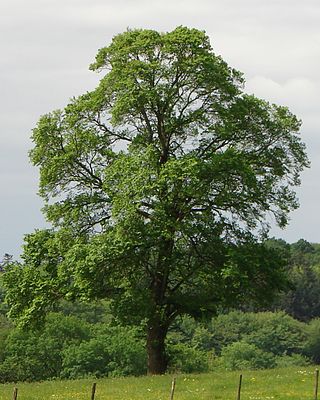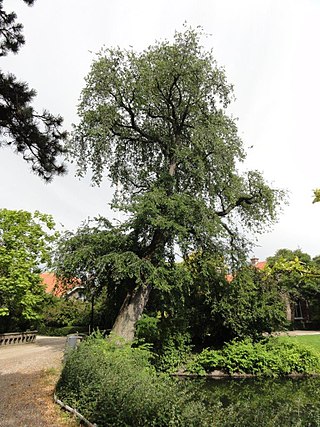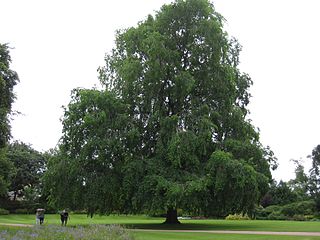
Ulmus minorMill., the field elm, is by far the most polymorphic of the European species, although its taxonomy remains a matter of contention. Its natural range is predominantly south European, extending to Asia Minor and Iran; its northern outposts are the Baltic islands of Öland and Gotland, although it may have been introduced by humans. The tree's typical habitat is low-lying forest along the main rivers, growing in association with oak and ash, where it tolerates summer floods as well as droughts.

The hybrid elm cultivar Ulmus × hollandica 'Smithii', commonly known as the Downton Elm, was one of a number of cultivars arising from the crossing of the Wych Elm U. glabra with the Field Elm U. minor. The tree was originally planted at Downton Castle near Ludlow, as one of a batch, not all of them pendulous in habit, raised at Smith's Nursery, Worcester, England, from seeds obtained from a tree in Nottingham in 1810.

The Wych Elm cultivar Ulmus glabra 'Horizontalis', commonly known as the Weeping Wych Elm or Horizontal Elm, was discovered in a Perth nursery circa 1816. The tree was originally identified as 'Pendula' by Loddiges (London), in his catalogue of 1836, a name adopted by Loudon two years later in Arboretum et Fruticetum Britannicum, 3: 1398, 1838, but later sunk as a synonym for 'Horizontalis'.

The Field Elm cultivar Ulmus minor 'Propendens', described by Schneider in 1904 as U. glabra (:minor) var. suberosa propendens, Weeping Cork-barked elm, was said by Krüssmann (1976) to be synonymous with the U. suberosa pendula listed by Lavallée without description in 1877. Earlier still, Loudon's Arboretum et Fruticetum Britannicum had included an illustration of a pendulous "cork-barked field elm", U. campestris suberosa. An U. campestris suberosa pendula was in nurseries by the 1870s.
The elm cultivar Ulmus 'Rugosa' [:'wrinkled', the leaves], was first listed in Audibert's Tonelle (1817), as "U. campestris Linn. 'Rugosa' = orme d'Avignon [Avignon elm] ", but without description. A description followed in the Revue horticole, 1829. Green (1964) identified this cultivar with one listed by Hartwig and Rümpler in Illustrirtes Gehölzbuch (1875) as Ulmus montana var. rugosaHort.. A cultivar of the same name appeared in Loddiges' catalogue of 1836 and was identified by Loudon in Arboretum et Fruticetum Britannicum (1838) as Ulmus montana var. rugosaMasters, Masters naming the tree maple-bark elm. Ulmus montana was used at the time both for wych cultivars and for some cultivars of the Ulmus × hollandica group.

The Siberian Elm cultivar Ulmus pumila 'Pendula' is from northern China, where it is known as Lung chao yü shu. It was classified by Frank Meyer in Fengtai in 1908, and introduced to the United States by him from the Peking Botanical Garden as Weeping Chinese Elm. The USDA plant inventory record (1916) noted that it was a "rare variety even in China". It was confirmed as an U. pumila cultivar by Krüssmann (1962).
The elm cultivar Ulmus 'Folia Variegata Pendula' was described by C. de Vos in 1867, as Ulmus suberosa folia variegata pendula. Green considered it possibly one of a number of Ulmus × hollandica cultivars, arising from the crossing of Wych Elm Ulmus glabra with Field Elm Ulmus minor.

The American elm cultivar Ulmus americana 'Pendula' was originally listed by William Aiton in Hort. Kew, 1: 320, 1789, as U. americana var. pendula, cloned in England in 1752 by James Gordon. From the 1880s the Späth nursery of Berlin supplied a cultivar at first listed as Ulmus fulva (Michx.) pendulaHort., which in their 1899 catalogue was queried as a possible variety of U. americana, and which thereafter appeared in their early 20th-century catalogues as U. americana pendula. The Scampston Elm, Ulmus × hollandica 'Scampstoniensis', in cultivation on both sides of the Atlantic in the 19th and 20th centuries, was occasionally referred to as 'American Weeping Elm' or Ulmus americana pendula. This cultivar, however, was distinguished by Späth from his Ulmus americana pendula.
The Field Elm cultivar Ulmus minor 'Microphylla Pendula', the Weeping small-leaved elm, was first listed by the Travemünde nursery, Lübeck, and described by Kirchner in Petzold & Kirchner's Arboretum Muscaviense (1864), as Ulmus microphylla pendulaHort.. By the 1870s it was being marketed in nurseries in Europe and America as Ulmus campestris var. microphylla pendula.
The elm cultivar Ulmus 'Lombartsii' is considered "possibly Ulmus × hollandica or Ulmus carpinifolia " by Green (1964). The tree was raised by Lombarts Nurseries at Zundert, Netherlands, circa 1910.

The Field Elm cultivar Ulmus minor 'Pendula' was said to have been raised in Belgium in 1863. It was listed as Ulmus sativa pendula by C. de Vos in 1887, and by Boom in 1959 as a cultivar.
The Wych Elm cultivar Ulmus glabra 'Pendula Macrophylla', was first mentioned by Maxwell ex Journal of the Royal Horticultural Society 18: 91, 1895, as U. montana var. pendula macrophylla, but without description.
The Wych Elm cultivar Ulmus glabra 'Pendula Variegata' was first described in 1850, and later by J. F. Wood in The Midland Florist and Suburban Horticulturist (1851) as U. montana pendula variegata, the 'broad-leaved variegated weeping mountain elm', and was said by him to have originated in and been distributed by the Pontey nursery of Kirkheaton, Huddersfield, Yorkshire. It was listed by Hartwig & Rümpler in Illustrirtes Gehölzbuch (1875) as Ulmus montana (:glabra) var. pendula variegataHort.

The elm cultivar Ulmus 'Scampstoniensis', the Scampston Elm or Scampston Weeping Elm, is said to have come from Scampston Hall, Yorkshire, England, before 1810. Loudon opined that a tree of the same name at the Royal Horticultural Society's Garden in 1834, 18 feet (5.5 m) high at 8 years old "differed little from the species". Henry described the tree, from a specimen growing in Victoria Park, Bath, as "a weeping form of U. nitens" [:Ulmus minor ]; however Green considered it "probably a form of Ulmus × hollandica". Writing in 1831, Loudon said that the tree was supposed to have originated in America. U. minor is not, however, an American species, so if the tree was brought from America, it must originally have been taken there from Europe. There was an 'American Plantation' at Scampston, which may be related to this supposition. A number of old specimens of 'Scampstoniensis' in this plantation were blown down in a great gale of October 1881; younger specimens were still present at Scampston in 1911.

The Siberian elm cultivar Ulmus pumila 'Dwarf Weeper' was discovered in a western Illinois garden and sold by the Arborvillage Nursery Holt, Missouri.
The Field Elm cultivar Ulmus minor 'Rugosa' was distributed by the Späth nursery, Berlin, in the 1890s and early 1900s as U. campestris rugosaKirchner. Kirchner's tree, like Späth's a level-branched suberose field elm, was received from Belgium in 1864 as Ulmus rugosa pendula. Kirchner stressed that it was different from Loudon's Ulmus montana var. rugosa, being "more likely to belong to U. campestris or its subspecies, the Cork-elm".

Ulmus × hollandica 'Wentworthii Pendula', commonly known as the Wentworth Elm or Wentworth Weeping Elm, is a cultivar with a distinctive weeping habit that appears to have been introduced to cultivation towards the end of the 19th century. The tree is not mentioned in either Elwes and Henry's or Bean's classic works on British trees. The earliest known references are Dutch and German, the first by de Vos in Handboek tot de praktische kennis der voornaamste boomen (1890). At about the same time, the tree was offered for sale by the Späth nursery of Berlin as Ulmus Wentworthi pendulaHort.. The 'Hort.' in Späth's 1890 catalogue, without his customary label "new", confirms that the tree was by then in nurseries as a horticultural elm. De Vos, writing in 1889, states that the Supplement to Volume 1 includes entries announced since the main volume in 1887, putting the date of introduction between 1887 and 1889.
The field elm cultivar Ulmus minor'Viminalis Pendula', a weeping form of U. minor 'Viminalis', was first listed c.1890 as Ulmus antarctica pendulaHort., and briefly described, by the Späth nursery of Berlin, which distributed it from the late 19th century. On the continent it was also known as U. campestris antarctica pendula. Maxwell T. Masters in the Journal of the Royal Horticultural Society (1891) listed it as U. viminalis pendula.
The elm cultivar Ulmus 'Crispa Pendula', the weeping fernleaf elm, was listed in the Gardeners' Chronicle & New Horticulturist (1873) as Ulmus crispa pendula, a variety of 'Crispa', itself described as "of the U. montana type".